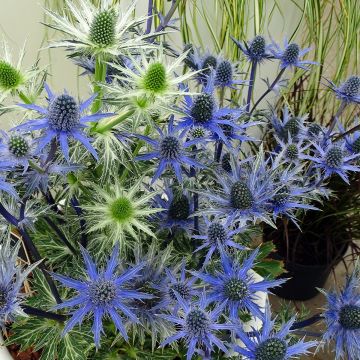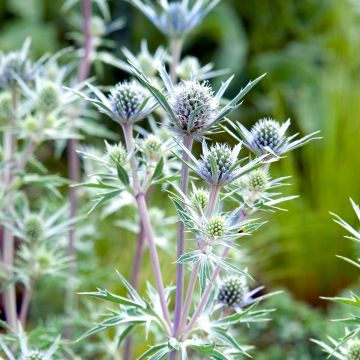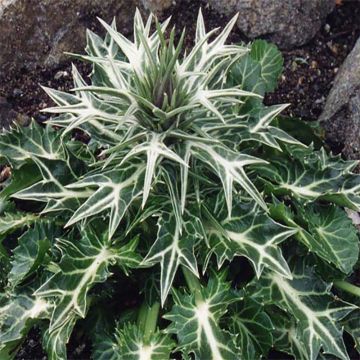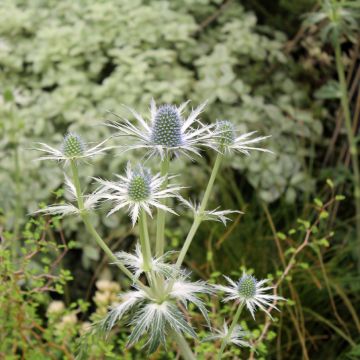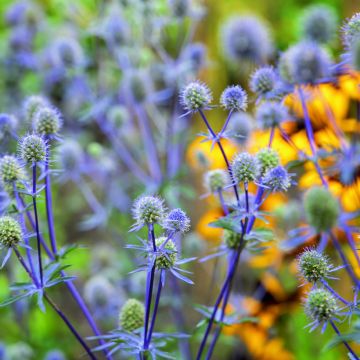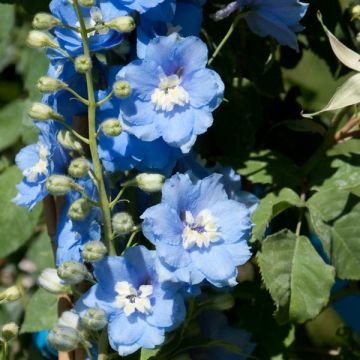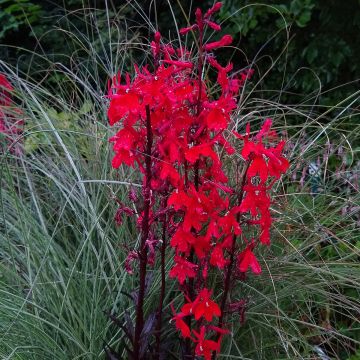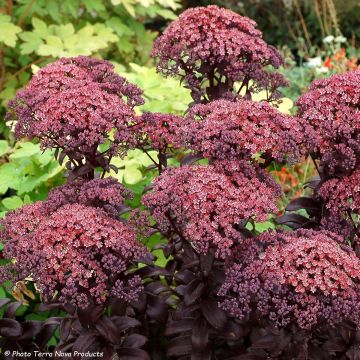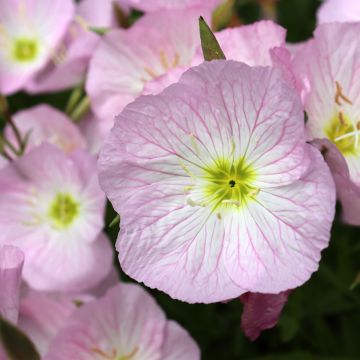

Eryngium ebracteatum var. poterioides
Eryngium ebracteatum var. poterioides
Eryngium ebracteatum var. poterioides
Burnet-flowered Sea Holly
Hello, ordered 3 identical young plants, impeccable packaging and delivery, but the specimens are disappointing, with a phytosanitary passport indicating a Dutch origin and original packaging in a 3l size. Upon arrival, the plants have very few roots, which probably indicates a very recent potting. They are packaged in a 3l bucket, but considering the small size of the plant, it would have been more commercially correct to present it in a pot. Granted, these specimens were on promotion, but in the end, the price is still not in line with the volume of the plant. It's disappointing...
MARIE, 19/06/2021
Why not try an alternative variety in stock?
View all →This plant carries a 12 months recovery warranty
More information
We guarantee the quality of our plants for a full growing cycle, and will replace at our expense any plant that fails to recover under normal climatic and planting conditions.
From €5.90 for pickup delivery and €6.90 for home delivery
Express home delivery from €8.90.

Does this plant fit my garden?
Set up your Plantfit profile →
Description
Eryngium ebracteatum var. poterioides is a wild sea holly that is not often found in gardens or nurseries. This perennial and evergreen species is a hardy plant despite its South American origins. It is interesting for its ability to grow in poor and dry soils and for its very long summer to autumn flowering. Its small conical and elongated inflorescences, similar to those of Sanguisorba, are produced abundantly on tall branched stems that emerge from rosettes of long green-grey leaves. It looks stunning when planted en masse, or combined with other wild meadow plants like Rudbeckia, thistles or grasses. Its flowers are also beautiful in fresh or dried wild bouquets.
Eryngium ebracteatum var. poterioides, called 'sea holly with burnet-like flowers' caused a sensation at Plantarium in 2016. However, this sea holly is neither a new horticultural creation nor a hybrid, but a wild perennial of the Apiaceae family native to the Atlantic coasts of Argentina and Paraguay. Its natural habitat consists of savannas. It is a perennial herbaceous plant with evergreen vegetation throughout the year, even in winter. When mature, this Eryngium reaches a height of about 1.20 m (4ft) to 1.40 m (5ft) when flowering, with a spread of 50 cm (20in), depending on the growing conditions.
The foliage is gathered in basal rosettes, composed of linear to lanceolate leaves, 12 to 50 cm (5 to 20in) in length and 0.5 to 3 cm (0 to 1in) in width. They are slightly spiny, sheathing at the base. Their colour is a slightly greyish green.
The flowering occurs from July to September-October. Tall branched stems emerge from the rosettes. Each branch carries at its end a cylindrical inflorescence measuring 1 to 2 cm (0 to 1in) in length and 2 to 4 mm (0.5in) in width. Each inflorescence is composed of tiny dark red to brown flowers surrounded by more silvery bracts.
This Blue Thistle appreciates sun and poor, sandy and rocky, well-drained soils, as close as possible to its natural habitat. It will therefore be ideal in a seaside garden or in a large gravel bed. Very decorative with its beautiful stature and long flowering period, this sea holly will be the perfect companion for plants that thrive in poor soils such as grasses (Stipa, Panicum, Pennisetum, Muhlenbergia), Artemisias, Rudbeckia, drought-tolerant Euphorbias and lavenders, in a very natural or contemporary setting. This thistle with its brown-red flowers is one of the best plants for creating splendid dried bouquets. Simply cut the stems before the flowers fully bloom and dry them upside down.
The roots of this coastal Sea Holly are edible and, after boiling and grilling, have a taste reminiscent of chestnuts. In the United Kingdom, they were used to make sweets.
Report an error about the product description
Eryngium ebracteatum var. poterioides in pictures


Flowering
Foliage
Plant habit
Botanical data
Eryngium
ebracteatum var. poterioides
Apiacées
Burnet-flowered Sea Holly
South America
Other Eryngium - Eryngo
Planting and care
Eryngium ebracteatum var. poteriodes, a perennial plant that thrives under optimum growing conditions, is hardy to -15°C (5°F). It is preferably planted in spring, in a sunny location, in ordinary but light, sandy or gravelly soil, with minimal limestone content, and a well-drained soil that is dry to moist. It does not tolerate heavy and wet soils, especially during the winter season. In case of heavy soil or in excessively wet soil, it is advisable to mix compost, sand, and gravel with garden soil and plant it in a raised bed. To ensure proper drainage, it is necessary to place a layer of gravel at the bottom of the planting hole. After flowering, remove the faded flowers, unless you want the seeds to disperse in the garden, thus obtaining spontaneous sowing and new young plants. Eryngiums can be attacked by aphids on the stems and inflorescences, as well as on their roots, weakening the plants and sometimes causing their decline (root rot). Moreover, they can be susceptible to powdery mildew and attacked by snails and slugs.
Planting period
Intended location
Care
-
, onOrder confirmed
Reply from on Promesse de fleurs
Summer flowering perennials
Haven't found what you were looking for?
Hardiness is the lowest winter temperature a plant can endure without suffering serious damage or even dying. However, hardiness is affected by location (a sheltered area, such as a patio), protection (winter cover) and soil type (hardiness is improved by well-drained soil).

Photo Sharing Terms & Conditions
In order to encourage gardeners to interact and share their experiences, Promesse de fleurs offers various media enabling content to be uploaded onto its Site - in particular via the ‘Photo sharing’ module.
The User agrees to refrain from:
- Posting any content that is illegal, prejudicial, insulting, racist, inciteful to hatred, revisionist, contrary to public decency, that infringes on privacy or on the privacy rights of third parties, in particular the publicity rights of persons and goods, intellectual property rights, or the right to privacy.
- Submitting content on behalf of a third party;
- Impersonate the identity of a third party and/or publish any personal information about a third party;
In general, the User undertakes to refrain from any unethical behaviour.
All Content (in particular text, comments, files, images, photos, videos, creative works, etc.), which may be subject to property or intellectual property rights, image or other private rights, shall remain the property of the User, subject to the limited rights granted by the terms of the licence granted by Promesse de fleurs as stated below. Users are at liberty to publish or not to publish such Content on the Site, notably via the ‘Photo Sharing’ facility, and accept that this Content shall be made public and freely accessible, notably on the Internet.
Users further acknowledge, undertake to have ,and guarantee that they hold all necessary rights and permissions to publish such material on the Site, in particular with regard to the legislation in force pertaining to any privacy, property, intellectual property, image, or contractual rights, or rights of any other nature. By publishing such Content on the Site, Users acknowledge accepting full liability as publishers of the Content within the meaning of the law, and grant Promesse de fleurs, free of charge, an inclusive, worldwide licence for the said Content for the entire duration of its publication, including all reproduction, representation, up/downloading, displaying, performing, transmission, and storage rights.
Users also grant permission for their name to be linked to the Content and accept that this link may not always be made available.
By engaging in posting material, Users consent to their Content becoming automatically accessible on the Internet, in particular on other sites and/or blogs and/or web pages of the Promesse de fleurs site, including in particular social pages and the Promesse de fleurs catalogue.
Users may secure the removal of entrusted content free of charge by issuing a simple request via our contact form.
The flowering period indicated on our website applies to countries and regions located in USDA zone 8 (France, the United Kingdom, Ireland, the Netherlands, etc.)
It will vary according to where you live:
- In zones 9 to 10 (Italy, Spain, Greece, etc.), flowering will occur about 2 to 4 weeks earlier.
- In zones 6 to 7 (Germany, Poland, Slovenia, and lower mountainous regions), flowering will be delayed by 2 to 3 weeks.
- In zone 5 (Central Europe, Scandinavia), blooming will be delayed by 3 to 5 weeks.
In temperate climates, pruning of spring-flowering shrubs (forsythia, spireas, etc.) should be done just after flowering.
Pruning of summer-flowering shrubs (Indian Lilac, Perovskia, etc.) can be done in winter or spring.
In cold regions as well as with frost-sensitive plants, avoid pruning too early when severe frosts may still occur.
The planting period indicated on our website applies to countries and regions located in USDA zone 8 (France, United Kingdom, Ireland, Netherlands).
It will vary according to where you live:
- In Mediterranean zones (Marseille, Madrid, Milan, etc.), autumn and winter are the best planting periods.
- In continental zones (Strasbourg, Munich, Vienna, etc.), delay planting by 2 to 3 weeks in spring and bring it forward by 2 to 4 weeks in autumn.
- In mountainous regions (the Alps, Pyrenees, Carpathians, etc.), it is best to plant in late spring (May-June) or late summer (August-September).
The harvesting period indicated on our website applies to countries and regions in USDA zone 8 (France, England, Ireland, the Netherlands).
In colder areas (Scandinavia, Poland, Austria...) fruit and vegetable harvests are likely to be delayed by 3-4 weeks.
In warmer areas (Italy, Spain, Greece, etc.), harvesting will probably take place earlier, depending on weather conditions.
The sowing periods indicated on our website apply to countries and regions within USDA Zone 8 (France, UK, Ireland, Netherlands).
In colder areas (Scandinavia, Poland, Austria...), delay any outdoor sowing by 3-4 weeks, or sow under glass.
In warmer climes (Italy, Spain, Greece, etc.), bring outdoor sowing forward by a few weeks.


































